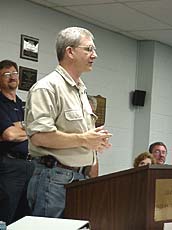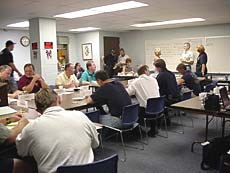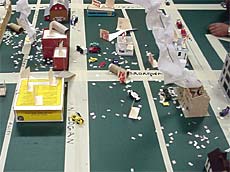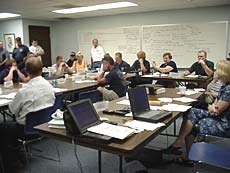|
Members of the Emergency Services and
Disaster Agency ask themselves that question often. It’s part of
their job. And when they ask the questions, they have to come up
with answers, usually fast.
As part of their training, state and
federal Emergency Management Agencies mandate regular exercises that
simulate some kind of local emergency. One of these simulations,
called a tabletop exercise, took place on Sunday in the lower level
of the Logan County Safety Complex on Pekin Street.
The 52 emergency responders gathered
without knowing what kind of situation they would be asked to cope
with. Soon-to-be-retiring Illinois Emergency Management Agency
Region Seven Coordinator Pat Keane designed the exercise. He said he
was going to make it a tough one.

[Photos by Jan Youngquist]
[Pat Keane]
"This will be a real disaster. You can
survive it, but you can’t beat it," he told them.
So, at approximately 12:45 p.m. on a
pleasant September Sunday, a 727 Air Freight jet plane with a crew
of three and 12,000 gallons of fuel on board crashed into downtown
Lincoln. Part of its cargo was liquid oxygen canisters, which would
become an accelerant for the fire.
The "crash" occurred in one room, where
a large tabletop layout showed Lincoln streets and buildings from
Sangamon to Kankakee and from Pekin to Pulaski streets. This room
became the Incident Command Center, with representatives of various
fire, rescue and law enforcement systems gathered around the table
directing the operations of their crews. Mark Miller, Lincoln City
assistant fire chief, was first on the scene in command.
In another room, various local agencies
set up an Emergency Operations Center, where representatives of fire
and rescue services, police, health care systems, local government,
and a disaster intelligence team worked to get the on-site team the
help they needed, protect Lincoln residents and keep track of what
was happening. Terry Storer, assistant director of ESDA, was in
command there.

[Emergency Operations Center]
In still another room, radio
dispatchers and amateur radio operators were getting the word out to
other agencies.
The plane came down north of Sangamon,
and the crash scattered pieces of the burning plane throughout the
area. Apartments in the vicinity were in flames immediately, along
with Marketplace Electric. Flames also engulfed Lincoln Junior High
School and the Methodist Church.
Firefighters from Lincoln City were
soon on the scene, followed by Lincoln Rural firefighters. Buildings
were evacuated whenever possible and injured people transported to
Abraham Lincoln Memorial Hospital.
Not long after the crash, the roof of
Lincoln Junior High School started to collapse. Fortunately it was
Sunday and school was not in session, but firefighters feared for
those who might still be in the area churches, especially the
Methodist Church. Its roof, too, was about to go.

The workers at the scene called for
reinforcements. They needed more ambulances and more fire
suppression units.
Help came from the neighboring fire
departments in New Holland, Mount Pulaski and Hartsburg, but because
the exercise was being conducted in "real time," that help didn’t
arrive immediately. Eventually 13 fire departments were called in,
including those from Springfield and Bloomington.

[Map of downtown Lincoln used in Emergency Operations
Center]
Paramedics had local ambulances on the
scene quickly, but they also had to wait for more ambulances from
outlying areas and for the helicopters that would airlift burn
victims to Springfield hospitals. A triage area for the injured was
set up near Central School.
Lincoln Police Department and the Logan
County Sheriff’s Department activated all off-duty personnel.
At least a dozen buildings were soon
heavily involved. Fires that had been put out reignited, engulfing
six blocks of downtown Lincoln.
The choice of where to focus efforts
was asked again and again, "What are the greatest health and safety
needs at this time?"
The Methodist Church would clearly be
totally destroyed, along with the junior high school. Vehicles were
on fire, and victims were on the ground.
[to top of second column in this
article] |

The Fricke-Calvert-Schrader Funeral
Home and Pete’s Hardware on Logan Street were soon gone, along with
all of the stores and apartments fronting Sangamon Street between
Broadway and Pulaski.
To make the exercise as realistic as
possible, toy trucks and ambulances were moved into the positions
they would have taken if the disaster had been real. As more and
more buildings began burning, they were labeled with markers showing
red flames. Plumes of smoke (paper on sticks) went up.

[Tabletop Lincoln: Debris and smoke cover the
downtown area.]
In spite of the toys on the table, the
mood in the Command Center remained serious. Tension grew as
firefighters and paramedics waited for the help they needed. The
crew in the Operations Center were also tense, busy keeping track of
the action and working out the strategy to cope with the unforeseen
disaster.
Firefighters evaluated what they
thought could be saved, checking the wind direction to see which way
the fire would spread. They were concerned that plumes of smoke were
moving toward the hospital, which was rapidly filling with the
injured.
The Illinois Central railroad line was
closed shortly after the plane crashed, and later all Interstate 55
exits into Lincoln and state highways 121 and 10 through Lincoln
were closed.
A news release reported that ALMH was
at maximum capacity and a medical shelter had been set up at Lincoln
Community High School, where Logan County Health Department staff
and Red Cross volunteers were on-site to provide medical care.
A sheltering and information center was
also set up at Logan Lanes on Fifth Street. Friends and relatives
searching for loved ones were directed to this center.

The sewage treatment plant was
overwhelmed with water from the firefighting effort and had to go on
bypass, so Lincoln residents were asked to restrict water use.
Land-based telephone lines were out as well.
By the time firefighters had begun to
get the fire under control, at least 30 bodies had been found and at
least 50 of the wounded had been transported to other hospitals. Two
firefighters had been seriously injured and were hospitalized.
When the exercise ended, a little more
than two hours later, the emergency responders gathered back
together as a group for a couple more hours in the Crisis Management
Center to review the exercise and evaluate their performance. Two
observers from IEMA were also evaluating the exercise and will be
sending their written reports to the local ESDA soon.
Many crew members had suggestions about
ways to improve the operation. Better lines of communication and
more personnel were needed, some said. Headsets for emergency
personnel, direct phone lines to department heads, maps and global
positioning systems, more participation by local officials, and a
brand-new role, a team to focus on what would be happening in the
future, were suggested.
"Now we know where we have to go," Dan
Fulscher, ESDA director, said at the end of the discussion.

[Debriefing after the mock emergency]
Fulscher thanked all those who
participated, which included Lincoln City and Lincoln Rural Fire
Protection Districts, Phoenix Fire Department of Mount Pulaski,
Armington Fire Department, Logan County Health Department, Abraham
Lincoln Memorial Hospital, Logan Paramedic Association, Central
Illinois Economic Development Corporation, Lincoln Police
Department, Logan County Sheriff’s Mounted Auxiliary Police, Logan
County Local Emergency Planning Committee, ESDA and LEPC Public
Information Team, Lincoln Street and Alley Department, Mount Pulaski
Street Department, Logan County Mounted Search and Rescue Team, AES/CILCO,
and the American Red Cross.
When the
exercise ended, emergency responders headed home, glad to drive
through downtown Lincoln and see that everything looked just the way
it had four hours ago, before the plane crash.
[Joan Crabb] |